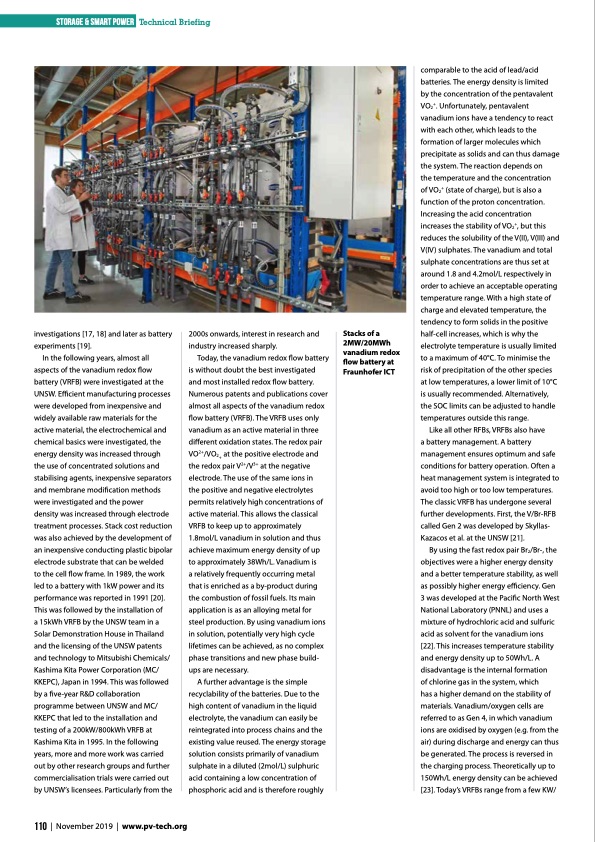
PDF Publication Title:
Text from PDF Page: 005
Storage & smart power investigations [17, 18] and later as battery experiments [19]. In the following years, almost all aspects of the vanadium redox flow battery (VRFB) were investigated at the UNSW. Efficient manufacturing processes were developed from inexpensive and widely available raw materials for the active material, the electrochemical and chemical basics were investigated, the energy density was increased through the use of concentrated solutions and stabilising agents, inexpensive separators and membrane modification methods were investigated and the power density was increased through electrode treatment processes. Stack cost reduction was also achieved by the development of an inexpensive conducting plastic bipolar electrode substrate that can be welded to the cell flow frame. In 1989, the work led to a battery with 1kW power and its performance was reported in 1991 [20]. This was followed by the installation of a 15kWh VRFB by the UNSW team in a Solar Demonstration House in Thailand and the licensing of the UNSW patents and technology to Mitsubishi Chemicals/ Kashima Kita Power Corporation (MC/ KKEPC), Japan in 1994. This was followed by a five-year R&D collaboration programme between UNSW and MC/ KKEPC that led to the installation and testing of a 200kW/800kWh VRFB at Kashima Kita in 1995. In the following years, more and more work was carried out by other research groups and further commercialisation trials were carried out by UNSW’s licensees. Particularly from the 2000s onwards, interest in research and industry increased sharply. Today, the vanadium redox flow battery is without doubt the best investigated and most installed redox flow battery. Numerous patents and publications cover almost all aspects of the vanadium redox flow battery (VRFB). The VRFB uses only vanadium as an active material in three different oxidation states. The redox pair VO2+/VO2+ at the positive electrode and the redox pair V2+/V3+ at the negative electrode. The use of the same ions in the positive and negative electrolytes permits relatively high concentrations of active material. This allows the classical VRFB to keep up to approximately 1.8mol/L vanadium in solution and thus achieve maximum energy density of up to approximately 38Wh/L. Vanadium is a relatively frequently occurring metal that is enriched as a by-product during the combustion of fossil fuels. Its main application is as an alloying metal for steel production. By using vanadium ions in solution, potentially very high cycle lifetimes can be achieved, as no complex phase transitions and new phase build- ups are necessary. A further advantage is the simple recyclability of the batteries. Due to the high content of vanadium in the liquid electrolyte, the vanadium can easily be reintegrated into process chains and the existing value reused. The energy storage solution consists primarily of vanadium sulphate in a diluted (2mol/L) sulphuric acid containing a low concentration of phosphoric acid and is therefore roughly Stacks of a 2MW/20MWh vanadium redox flow battery at Fraunhofer ICT comparable to the acid of lead/acid batteries. The energy density is limited by the concentration of the pentavalent VO2+. Unfortunately, pentavalent vanadium ions have a tendency to react with each other, which leads to the formation of larger molecules which precipitate as solids and can thus damage the system. The reaction depends on the temperature and the concentration of VO2+ (state of charge), but is also a function of the proton concentration. Increasing the acid concentration increases the stability of VO2+, but this reduces the solubility of the V(II), V(III) and V(IV) sulphates. The vanadium and total sulphate concentrations are thus set at around 1.8 and 4.2mol/L respectively in order to achieve an acceptable operating temperature range. With a high state of charge and elevated temperature, the tendency to form solids in the positive half-cell increases, which is why the electrolyte temperature is usually limited to a maximum of 40°C. To minimise the risk of precipitation of the other species at low temperatures, a lower limit of 10°C is usually recommended. Alternatively, the SOC limits can be adjusted to handle temperatures outside this range. Like all other RFBs, VRFBs also have a battery management. A battery management ensures optimum and safe conditions for battery operation. Often a heat management system is integrated to avoid too high or too low temperatures. The classic VRFB has undergone several further developments. First, the V/Br-RFB called Gen 2 was developed by Skyllas- Kazacos et al. at the UNSW [21]. By using the fast redox pair Br2/Br-, the objectives were a higher energy density and a better temperature stability, as well as possibly higher energy efficiency. Gen 3 was developed at the Pacific North West National Laboratory (PNNL) and uses a mixture of hydrochloric acid and sulfuric acid as solvent for the vanadium ions [22]. This increases temperature stability and energy density up to 50Wh/L. A disadvantage is the internal formation of chlorine gas in the system, which has a higher demand on the stability of materials. Vanadium/oxygen cells are referred to as Gen 4, in which vanadium ions are oxidised by oxygen (e.g. from the air) during discharge and energy can thus be generated. The process is reversed in the charging process. Theoretically up to 150Wh/L energy density can be achieved [23]. Today’s VRFBs range from a few KW/ Technical Briefing 110 | November 2019 | www.pv-tech.orgPDF Image | Redox flow batteries for renewable energy storage

PDF Search Title:
Redox flow batteries for renewable energy storageOriginal File Name Searched:
Redox-flow-batteries.pdfDIY PDF Search: Google It | Yahoo | Bing
Salgenx Redox Flow Battery Technology: Salt water flow battery technology with low cost and great energy density that can be used for power storage and thermal storage. Let us de-risk your production using our license. Our aqueous flow battery is less cost than Tesla Megapack and available faster. Redox flow battery. No membrane needed like with Vanadium, or Bromine. Salgenx flow battery
| CONTACT TEL: 608-238-6001 Email: greg@salgenx.com | RSS | AMP |